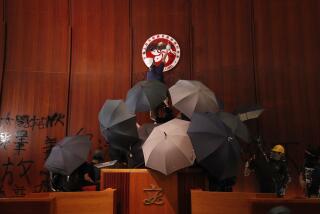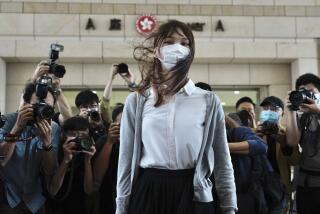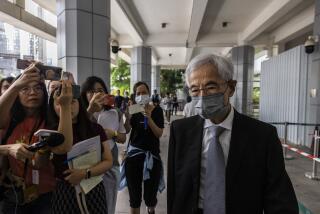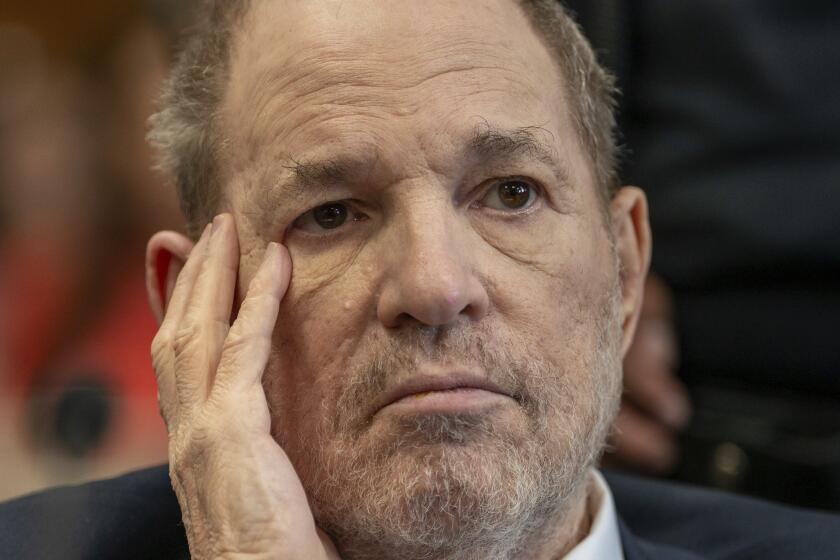Police remove barricades at one site of Hong Kong protests
As Hong Kong’s pro-democracy sit-ins continued into their third week early Monday, police began removing barricades that have blocked a key highway in the Central financial district.
With demonstrators in sparse numbers in the area, officers approached the western edge of the protest zone before 7 a.m. and began emptying water-filled plastic traffic dividers and loading metal barricades onto trucks.
Dressed not in riot gear but blue shirt sleeves, but with some carrying helmets and shields, the police appeared to be moving slowly east down the long-blocked thoroughfare of Connaught Road Central toward Admiralty, the district that is home to government headquarters and the heart of the protest zone. Police also removed barricades along Queensway, the main road in front of the Bank of China building in Central.
The action came a day after the territory’s Beijing-backed chief executive, Leung Chun-ying, said that student leaders had an “almost zero chance” of forcing Chinese authorities to drop their restrictive framework on rules for 2017 elections, which triggered the protests.
Demonstrators want the public to be able to nominate candidates for the chief executive election in 2017, but Chinese authorities in Beijing have said only two or three people may run and all would require the approval of a Beijing-friendly screening committee.
On Friday, protest leaders and representatives of Leung’s administration were scheduled to hold talks, but those plans broke down as the chief executive insisted that any discussions must take place within the framework of the guidelines handed down by Beijing.
With police moving in, the Hong Kong Federation of Students, one of the lead groups organizing the demonstrations, sent out urgent messages on social media urging supporters to return to the protest zones.
Police removing the barricades made confusing announcements, saying they were “just trying to move barriers, not clear protest sites.”
In the densely packed Mong Kok neighborhood, another sit-in site across Victoria Harbor from Central and Admiralty, police also attempted to remove barricades about 6 a.m. However, demonstrators camped out overnight in the area woke up and apparently stopped the officers.
Over the weekend, student protest leaders issued an open letter to Chinese President Xi Jinping, emphasizing that theirs was not a “color revolution” that aims to overthrow Chinese rule but “a movement by Hong Kongers in pursuit of democracy.”
The letter blamed Leung for the more than two-week standoff.
The students asked Xi to uphold the principle of “one country, two systems” under which Hong Kong, a former British territory, returned to Chinese rule in 1997. That arrangement promised Hong Kong a high degree of autonomy for 50 years and a gradual move toward a system of “universal suffrage” for the chief executive elections.
“Genuine universal suffrage does not mean taking power from the central government,” the letter said. “It is a manifestation of [Hong Kong’s] high degree of autonomy and administrative rights.”
The letter said the central government should be “confident” and not fear allowing Hong Kong voters to freely choose their chief executive. The introduction of such a system, the students told Xi, would be a “pioneering achievement.”
Protest leaders have called on Leung to resign, but he has refused.
Follow @dhpierson and @JulieMakLAT on Twitter for news out of the Hong Kong protests
More to Read
Start your day right
Sign up for Essential California for news, features and recommendations from the L.A. Times and beyond in your inbox six days a week.
You may occasionally receive promotional content from the Los Angeles Times.








